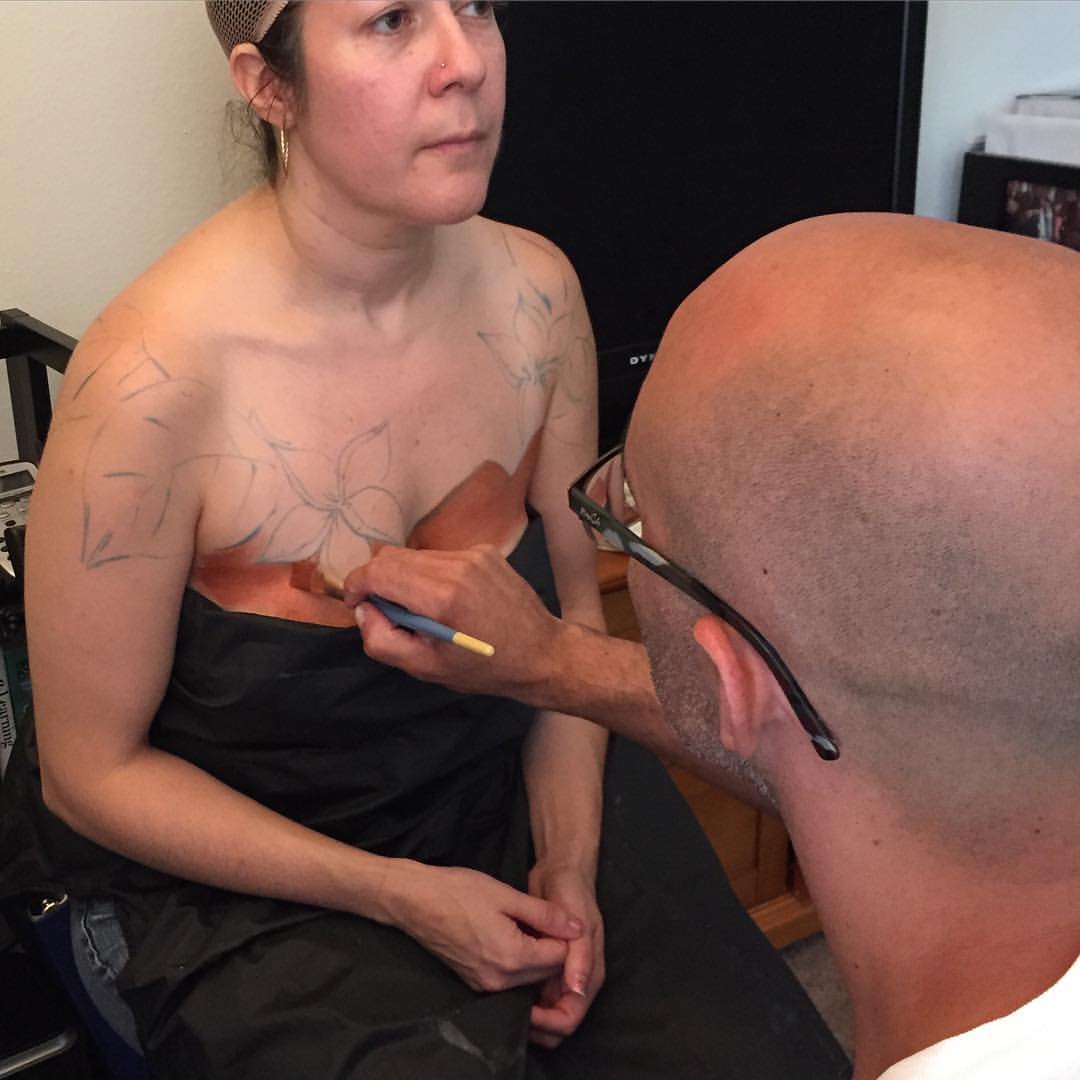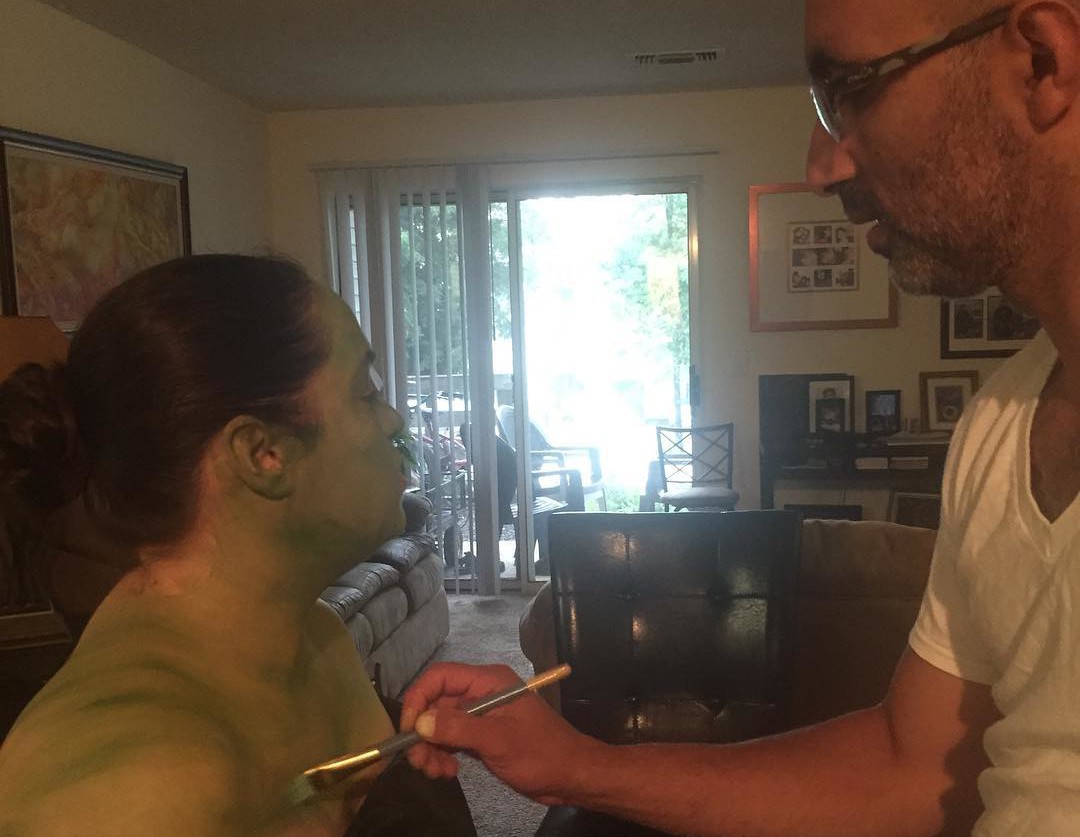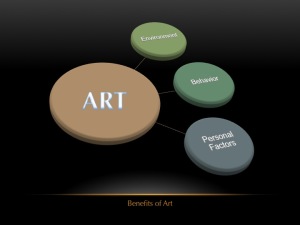Body Painting Therapy

I do not have scientific proof for the benefits of body painting therapy. I do know that body painting can be therapeutic in many ways. The process of transformation is a long and tiresome process but despite this it is very relaxing and soothing for the person becoming art. It allows for a time of disconnect. The real world starts fading away as a new reality emerges in which the model is the main character. This also brings an effect of amusement to those who are observing the process. Believe me, looking at the product of the body painting doesn’t compare to witnessing the process.
 Body painting allows a person to see something about them that is often hidden deep inside. I try to design and paint on a person something that I see in their personality or character. “More than meets the eye” is often said but how often we allow to dig deeper inside ourselves to see what others see in us? It is easy to look inside someone else and see what we don’t see. By painting on someone, I aim to allow them to see what I see about them so they can see it too. It is art even when I paint a generic design on someone, but it becomes therapy when the vision of the artist is linked to the person being painted.
Body painting allows a person to see something about them that is often hidden deep inside. I try to design and paint on a person something that I see in their personality or character. “More than meets the eye” is often said but how often we allow to dig deeper inside ourselves to see what others see in us? It is easy to look inside someone else and see what we don’t see. By painting on someone, I aim to allow them to see what I see about them so they can see it too. It is art even when I paint a generic design on someone, but it becomes therapy when the vision of the artist is linked to the person being painted.
 As you may know by now, I don’t just do things for the sake of art or entertainment. I am looking for something else of deep value in everything I do. I am looking for some way to impact the lives of those who encounter my art in some way. The Art of Iván Tirado LLC is much more than just traditional painting and sculpting. Paintings and sculptures are dead if they have no connection to people. The value of speaking and teaching about these things abides in what people can use to make even a slight difference in their lives. It is no different with body painting.
As you may know by now, I don’t just do things for the sake of art or entertainment. I am looking for something else of deep value in everything I do. I am looking for some way to impact the lives of those who encounter my art in some way. The Art of Iván Tirado LLC is much more than just traditional painting and sculpting. Paintings and sculptures are dead if they have no connection to people. The value of speaking and teaching about these things abides in what people can use to make even a slight difference in their lives. It is no different with body painting.
 What if I could see in a person what he or she stopped seeing about himself or herself? What if that vision serves a purpose of healing? What if transforming a person in what is not seen with the naked eye allows to grow and boost self-confidence and a new appreciation of the self? What if body painting is used to help people as a form of therapy?
What if I could see in a person what he or she stopped seeing about himself or herself? What if that vision serves a purpose of healing? What if transforming a person in what is not seen with the naked eye allows to grow and boost self-confidence and a new appreciation of the self? What if body painting is used to help people as a form of therapy?


Intersubjective Artistic Matrix
For a while now I’ve been thinking about writing on a subject that for many artists may result in defensive argumentation, as I’ve seen in the past during some conversations and online discussions. However, it is a subject that deserves attention not to establish a definite interpretation of benefits or causes for rejection, but to understand the teaching and therapeutic benefits of engaging in this practice. In past posts, I explored the subject (read: How to Explain Your Art). During the summer I began reading the book Art Therapy and the Neuroscience of Relationships, Creativity, and Resiliency: Skills and Practices by Noah Hass-Cohen and Joanna Clyde Findlay, and they introduced to me the term “Intersubjective Artistic Matrix” (IAM). IAM defines the artist’s capacity to retain and explain the procedures utilized during the creation of a piece of art as if connecting subconscious and conscious processes.
In cognitive theory, knowledge is expressed in procedural fluency and conceptual understanding. How do we differentiate these two? There are many things we do without giving much thought. Certain procedures, with practice and repetition, become something like second nature to us. We know how to do it, so we just do it. At times, we find ourselves trying to explain what we are doing and fall short in putting into words all the elements and mental processes we often not pay attention to. Here is where conceptual understanding comes in. Conceptual understanding aligns connections and relationships between bits of information to create an explanation. Think of these two as practice and theory. There seems to be a debate about which of the two has more “knowledge value”. What if both are equally valuable? What if the context in which they are needed determines their value? What if both together are more valuable than each one of them separately? These are questions to be considered before rejecting one or the other. The more perspectives
We can expend time analyzing contexts where procedural fluency is required more than conceptual understanding, and the also the other way around. We might find contexts in which both are equally necessary. Nevertheless, the intention of looking at IAM is to seek understanding of when and how it becomes beneficial in the context of teaching and therapy. As an educator, and in my experience in the sculpting and painting parties, as well as in the classroom and private lessons, I find extremely important to have both. It could be counterproductive in a learning setting to do something for others to learn and not being able to explain the mental processes, and the procedures that interact in doing so. The opposite is also true. It is difficult to gain trust from the people we are trying to teach if we can explain all the nuances of a procedure but being incapable of doing it. Yes, there are some exceptions where it might not be necessary to prove we can do it, or situations in which we don’t have to explain what we are doing. Again, it all depends on the situation.
In therapy, and more specifically art therapy (I am not an art therapist although I had experience similar approaches within my classes) the benefits of this IAM is for the individual using art as a form of therapy. We can always try to interpret someone’s work based on our own understanding, knowledge, and biases. However, what if we could uncover the emotions and experiences from which the creation finds its inspiration and significance right from the source? What if the individual could find a way to open up to hidden emotions and experiences once expressed visually, through music, through writing, or other forms of art? Some might argue that art can speak by itself, but I can testify of how many interpretations of my art coming from other people have nothing to do with what I was thinking or feeling at the time of creation. Maybe we could give ourselves a chance to discover ourselves in our art, and allow others to do the same. Maybe someone else can find emotional and intellectual benefit in connecting process and concept if they are granted the chance to do so.